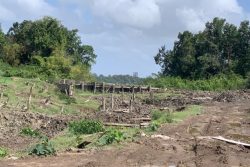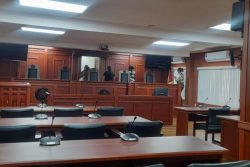Time was when the MV Kimbia docked at Kumaka once every fortnight. For the residents there that was an event in itself. It meant that an important social and commercial lifeline between the coast and Region One, and more particularly, Mabaruma, was still intact.
The arrival of the vessel would bring scores of people to the waterfront. It was a matter of gathering information on the types of goods that the boat had brought and determining whether packages of one sort or another had been sent by relatives and friends on the coast.
There is something worrying about the near complete dependence of remote interior communities on the periodic arrival of a vessel from Georgetown laden with most of the consumer goods upon which the community depends. Much could happen on the trip to its distant destination and when the vessel arrives there is a sense of relief amongst the residents. The vessel is welcomed for other practical reasons including the fact that a boatload of goods means temporary employment for dozens of residents, mostly men, serving as porters to unload the vessels then to move the cargo from the waterfront to nearby shops.
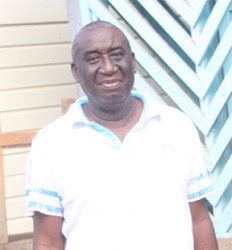
Over the past two months the periodicity of the MV Kimbia’s visits has reduced. The vessel has been arriving every three weeks. That has its consequences, including loss of income for the temporary porters and scarcity of consumer goods.
On the whole, Mabaruma is a farming community. The vegetables and root crops cultivated there are sold at the Kumaka waterfront. Tuesdays and Saturdays are important trading days. Farming apart, the community depends on hunting, fishing and logging, though some of the men have left the area for the goldfields at Port Kaituma.
Gary James is a second generation resident of Mabaruma. His father left Berbice for Region One during the 1960s. Several years ago, James created a business, buying root crops and vegetables from the resident farmers and shipping them to Georgetown. He recalls that ten years ago he lost the market to farmers from the Soesdyke/Linden highway on account of his own prohibitive shipping costs.
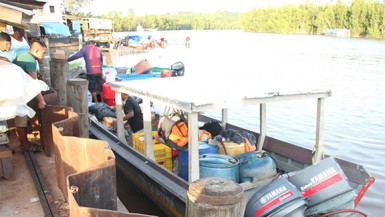
James has managed to survive the challenges of doing business in what, for years, has been an informal economy. He has expanded the range of his entrepreneurship to embrace a restaurant, a grocery and a petrol outlet. These can be lucrative establishments in an outpost community that still holds a measure of interest to coastlanders. People travel to and from Mabaruma for various reasons. The services that James provides are in demand.
The petrol consumed by the growing number of cars, buses, trucks and boats in Region One is imported directly from Venezuela. It is not a formalized bilateral arrangement but in the absence of an ability to deliver fuel from Georgetown the authorities cannot afford to frown on the arrangement. It is the same with much of the other types of trans-border interaction. Goods and services change hands continually in exchange for money and the complexities of a formal relationship between the two countries that is sometimes characterized mostly by deliberations over a border dispute are irrelevant to the beneficiaries on both sides. An absence of officialdom, however, has its downside. Sometimes the security personnel on the Venezuelan side – for one reason or another – staunch the flow of fuel to the other side. The uncertainties of such an arrangement are discomfiting to consumers on this side.
Some of the small shops in Mabaruma offer beverages manufactured in Venezuela and brought to Guyana in small boats. Other items including vegetables are brought on the boats too. The boats
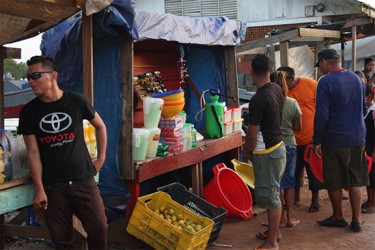
7.
arrive at Kumaka on Monday afternoons in time for the market days on Tuesdays. At the end of the trading day they move on to Port Kaituma to dispose of what is left of their cargo.
It is not that there is a complete dependence by Region One communities on consumer goods arriving from Georgetown, though there is clear and to some extent surprising evidence of the extent of the informal economy fashioned between the two sides.
Ginger is cultivated in considerable quantities in the Mabaruma sub-district. Production costs, however, have made successful commercialization of the pursuit prohibitive. It costs around $300,000 to clear an acre of land, $4,000 for a day’s labour and $15,000 to move a boatload of produce to the waterfront.
James says that often, his purchases from the farmers amount to patronage. The ginger farmers have no other means of earning a viable livelihood. He says he is encouraging the farmers to diversify into cash crops.
Abraham Daniel, a farmer who cultivates eddo and ginger at Hotoquai concurs. At the prevailing price of $80 per pound it is simply not worth the while to cultivate ginger and eddoes alone these days.
Along the Aruka River there is evidence of makeshift revetment works designed to prevent the water from inundating the farms. Drainage costs are left entirely up to the farmers and those costs continue to eat into their earnings. Some of them have become fatigued and frustrated by what they see as the pointlessness of an economic pursuit that continues to be largely unprofitable. The goldfields at Port Kaituma have been an option for some of them.
However, the recent fall in the price of gold has had a knock-on effect at Mabaruma. Many of the men from the township who had gone to Port Kaituma to work as miners have now returned home. While there are still signs of commercial activity in the township there is, it seems, less money in circulation.
Residents admit that there is child labour. Children are involved in the movement of fuel from Venezuela into Region One. There are cases too where children cut short their schooling and head for the goldfields.
The local electricity service provides power for five hours each day, between 18:00 hrs and 23:00 hrs. Otherwise, residents rely on modest solar outfits and generators. Without cheaper, reliable power investment options are limited and the economic ‘crawl’ that the community is experiencing is masked by a façade of business, underlined particularly mostly by the constant movement of a fleet of vehicles that rush passengers to various destinations on poorly surfaced roads that churn up clouds of dust and deposit these everywhere, underlining the reality that the development of the country’s interior communities is still very much a work in progress.



